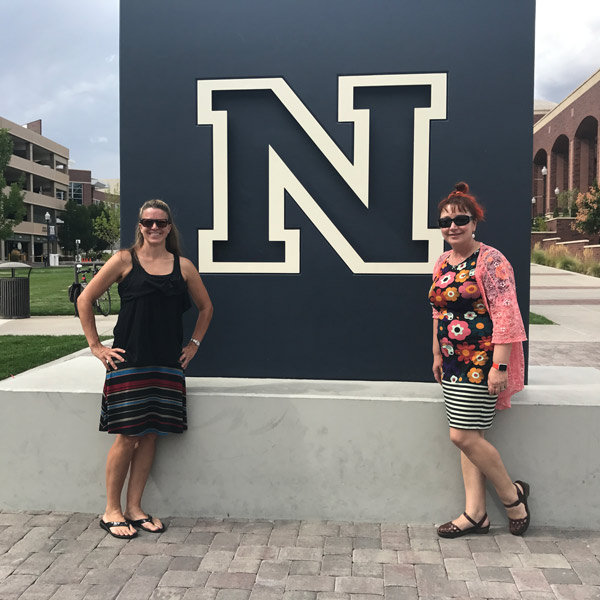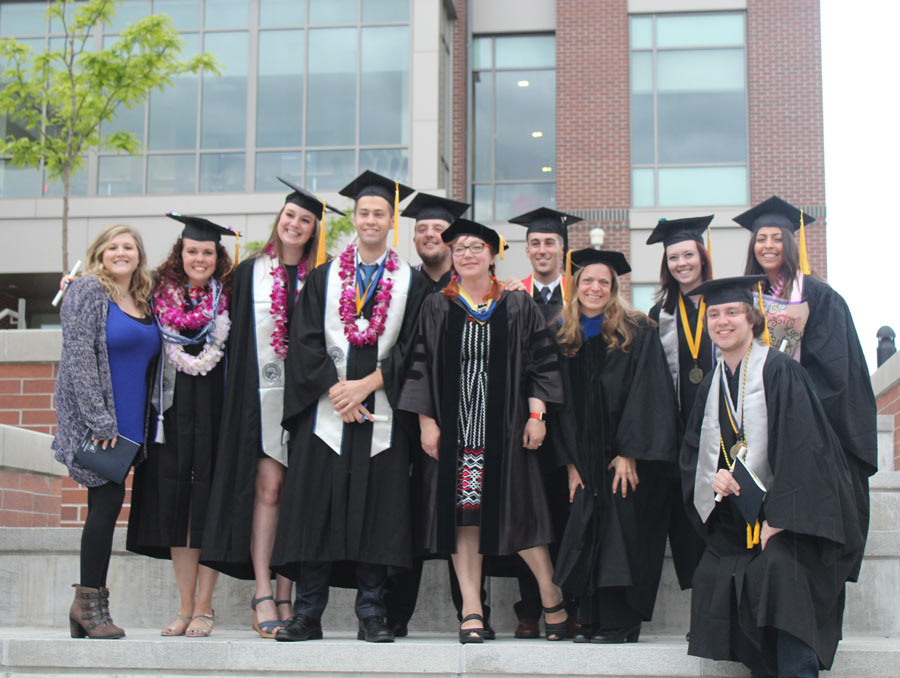Teachers have a knack for coming up with creative ways to promote student-centered learning. For two biology professors, that means helping students not only understand the content but to become STEM ambassadors and educators.
The Biology Peer Instruction Program was created by Teaching Professor Elena Pravosudova and Teaching Associate Professor Pamela Sandstrom. Each has a profound passion for fostering learning and teaching skills in their students. They teach Biology 190 (currently BIOL 190A, Introduction to Cellular and Molecular Biology) and Biology 300 (Genetics). The peer instruction program helps students who were successful in these classes become mentors and tutors to the next class of students, becoming experts on the course content in the process.
“Since 2008, nearly 500 undergraduates have collectively held over 1,200 leadership positions and helped us build a successful Peer Instruction Program,” Pravosudova said. The program has grown in its significance on campus and in the roles students can fill since its start.
A win-win-win
The College of Science is the largest college at the University, and Biology students comprise a huge part of the College. Those students all take Biology 190(A) and Biology 300, which means hundreds of students are taking the courses each semester. The Biology Peer Instruction Program can help the professors manage the massive classes.
“I call it a win-win-win,” said Pravosudova. “We get help teaching our students and engaging them. The students get help from peers, as it is always good for someone to explain it in a different way than the professor who might have a different learning style. And for the peer leaders, it’s the experience, it’s the connections. And just pragmatically, they’re exposed to the same content over and over again, so when they take any standardized test, they just kill it.”
"As mentors, Dr. Sandstrom and Dr. Pravosudova also indirectly contributed to my studies as they fostered a collaborative, inclusive environment that really allowed my leadership skills to flourish... I would not be the person I am today without these exceptional women."
Many of the students who work as peer mentors go on to medical school. One of those students is Brandon Conner. Conner completed the undergraduate portion of the BSMD program in 2018, then continued at the University of Nevada, Reno School of Medicine. He graduated from medical school in spring, and is now an Internal Medicine Resident in North Carolina.
“The most valuable part of being a peer mentor was realizing first-hand that the most effective way to learn something is to teach it,” Conner said. The same lessons he learned in Biology 190 as a student, then as a peer mentor, came up in his medical school classes. Even as a Resident, he recently discussed some of the same lessons with a patient. “Being able to explain the PCR test in layman’s terms to this patient in a way that they could understand came from my years of experience having to explain this information to students in discussion groups. And I think the fact that Biology 190 is still in the back of my mind speaks to how incredible being a peer instructor and mentor can be.” But the professors already knew these skills would come in handy for alumni of the program.
“Doctors are basically teachers for life, and that’s where they gain experience in how to explain science to the general public,” Sandstrom said.
Student roles
The program has a very organized flipped-classroom design. There are mandatory discussion groups for Biology 190 and 300 which compose a significant portion of student grades. Thus, it’s important to pick the right students to guide their peers toward success.
“Because of that, training of peer instructors has to be very structured. They have to gain particular leadership skills, have to learn to develop their own lesson plans given a sample template, and they have to have the same way of assessing their students’ success,” said Pravosudova.
The students who succeeded in the Biology 190 and 300 courses and decide to become peer mentors have a variety of roles they can assume, and there are opportunities for leadership positions within the program. Some of the positions are paid.
“We know a lot of them have bills to pay, and we would much rather have them make money contributing to success of their peers,” Pravosudova said. The students get the added benefit of learning as they work.
The roles are outlined below:
- Discussion Leaders: These peer instructors teach mandatory discussions for students enrolled in Biology 190 or Biology 300. The discussions are 50 minutes each week and cover a specific topic aligned with the lecture. Students in discussion groups (20-24 students per section) do active learning activities like small group problem-solving, reenacting biological processes, and educational games.
- Learning Assistants (LAs): LAs are typically returning peer instructors who are paid. The LAs go to lectures and provide active learning help in lecture during instant response question sessions. Each LA is usually assigned to a specific group of students in the lecture hall.
- Peer Mentors: A select few peer instructors become Peer Mentors who are paid to perform “quality control” by assessing discussion leaders during their sections, ensuring leaders are teaching students in a consistent way.
- Course Coordinators: Coordinators are paid and frequently also work as discussion leaders or learning assistants. There is one course coordinator per section of the course.
Discussion leaders and first-time learning assistants are required to take Biology 495 (Peer Leadership in Biology). Biology 495 is a 1-credit pedagogy course that counts toward the students’ degree requirements.
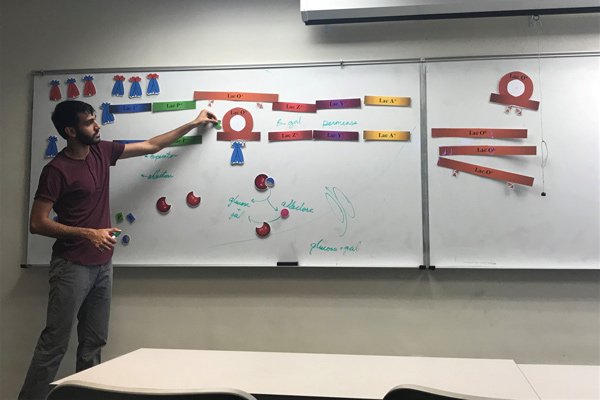
Peer instructors also work shifts at the Biology Help Center. Students can drop in at any time to get tutoring for most biology courses, both lower- and upper-division. Pravosudova said many of the peer instructors can be found hanging out at the Biology Help Center outside of their scheduled shifts.
“This develops a social structure centered on learning and helping others learn,” she said.
The Biology Peer Instruction Program isn’t restricted to students who are majoring in Biology. Many are pre-professional students, including pre-meds, but there are also art, public health and even engineering students. “There are a lot of pre-meds, but some want to do research,” Pravosudova said. “The one thing they have in common is they are all definitely Type-A, high achieving science students.”
“I think we also talk a lot of peer instructors into a second major or a minor in Biology if they do have a unique major,” Sandstrom said.
And the students who benefit from their peers’ instruction isn’t limited to biology, either. Community Health Sciences students who take Biology 189A benefit from Learning Assistants in their class. Many of the CHS students are also student athletes, so they often need extra help in maintaining their course load.
Ensuring that every student can see themselves as peer leaders is important to Pravosudova and Sandstrom.
“I’m hoping to keep increasing the diversity of our actual leaders so that students see themselves in the peer instructors. It’s nice that we have the ability to try to be more inclusive,” Sandstrom said.
Sandstrom and Pravosudova post applications to the Biology Peer Instruction Program about two thirds of the way through the semester. Over the summer or winter break, interviews are held for future peer instructors, which allows them to showcase their ability to help students learn, and effectively explain biological concepts.
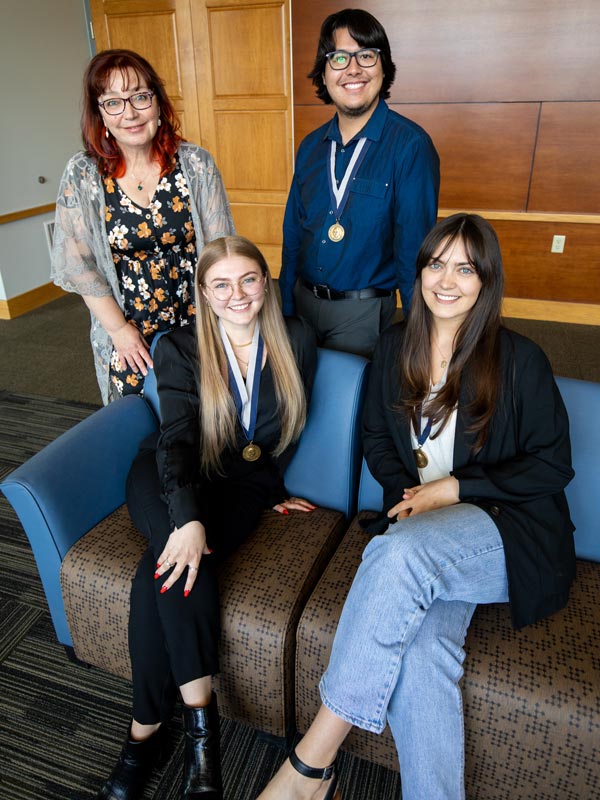
The application asks for students’ expected grades in their courses, their GPA and transcript, a written statement on why they want to be a peer instructor and a recommendation from their current discussion leader. Once they start, the real work begins.
“What’s amazing is how well they manage it all,” Sandstrom said. The students work hard to maintain good grades. In spring 2022, three of the Westfall Scholars, seniors who are graduated with the highest GPA in their program, were peer instructors. Peer instructors are not only balancing their own coursework but are also helping others, and often participating in volunteer or professional organizations to boost their résumé.
“That’s the key,” said Pravosudova. “I tell them the busier they are, the better off they are because they have to plan it really well.”
Teaching…and learning
The professors continue to improve and expand their peer instruction program. The University is a member of the Learning Assistant Alliance (LAA) that supports educators who want to use the flipped-classroom model and peer instruction. When the professors attend the LAA conferences, meetings and workshops, everyone benefits.
“We try to teach them what we have learned over the years. I feel a lot of that has come from the College of Science allowing us to get professional development, allowing us to go to those UTeach conferences, allowing us to go to those Learning Assistant Alliance conferences, and then we share all that knowledge with our peer instructors,” Sandstrom said.
Funding for the peer instruction program is provided by the College of Science. The money goes back to the peer instructors as stipends. The program (specifically the establishment of Learning Assistants) was supported heavily by former Associate Dean Gina Tempel, who encouraged Pravosudova and Sandstrom to pursue these types of programs with opportunities to attend conferences, webinars, workshops and other forms of professional development pertaining to peer instruction.
“Fortunately, the Dean’s office has been really supportive and has been providing us with supplemental budget to sustain our program for a while now,” Pravosudova said.
The College’s support has been critical to the program. Educational grants are short-term and course structure depends on the long-term support of the College and the University.
A legacy of learning
The program has been around for over a decade and a half, and its impact has been far-reaching.
“It’s a community of learners,” Sandstrom said. “It’s not just biology majors, not just College of Science majors, but it’s bigger than us here, and it’s bigger than this University, because these students are going out and many of them are going to professional school and still write us constantly that this made a difference to them.”
One former student and peer instruction program alumnus who invited Sandstrom to her dissertation defense wrote, “Thank you so much for believing in me and all your initial support, this would not be possible without you. … I cannot thank you enough for your inspiration and being a role model for women in STEM.”
At their spring graduation, four students from the Peer Instructor program got together for a photo. They told Sandstrom that they likely never would have known and become friends with each other if not for the program. Two of those students will be attending UNLV for medical school and dental school.
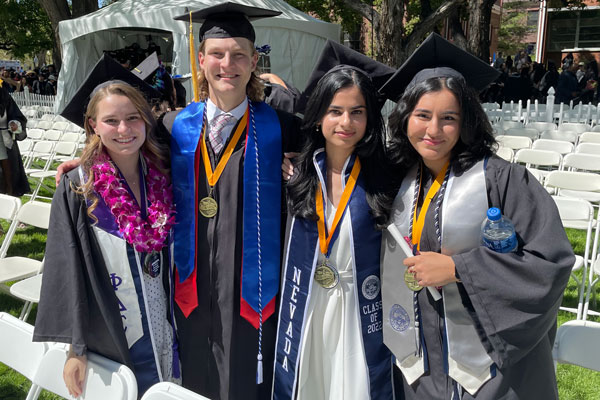
“They make community,” Sandstrom said.
The professors have had siblings of former peer instructors come through the program, following in their older siblings’ footsteps.
The COVID-19 pandemic impacted the program to an extent, but the motivated peer instructors powered through the chaos and confusion and provided new resources to their peers. Additional resources proved critical for a lot of students whose academic careers were suddenly upended.
“Programs like ours, I feel like that’s what keeps students engaged,” Pravosudova said.
Student Testimony
Praise for Professors
As much praise as the professors had for their students, the students returned doubly. Expand the boxes below to learn more about the impacts the program and professors have had on their students.
Brandon Conner graduated from UNR Med and is currently an Internal Medicine Resident at the University of North Carolina.
The peer instruction program armed me with the tools and skills necessary to educate individuals from a wide variety of educational/socioeconomic backgrounds and also showed me the importance of maintaining adaptability. Every individual you encounter learns and processes information differently, and the key to effective teaching is recognizing these differences and implementing a variety of teaching modalities to effectively relay information. The Biology Peer Instruction Program embraces this important principle, and you spend every week learning how to engage individuals through numerous active learning strategies. I consistently used these strategies as a medical student and achieved great success in all of my teaching endeavors as a result of this program’s influence.
Dr. Pravosudova and Dr. Sandstrom are some of the most remarkable professors I have ever had the pleasure of interacting with. They genuinely have a passion for raising the next generation of scientific educators regardless of students’ ultimate career path. Their influence has contributed in large part to my desire to work as an academic clinician, whereby I will teach medical students and residents on a daily basis. Their compassion, dedication, perseverance, and commitment are traits I will remember forever, and I can honestly say that my time at UNR would never have been the same without them. I hope the program they have created remains in place long after they retire, because it truly inspires so many students to take their learning to a whole new level.
Alec Brennan graduated in 2019 with dual majors in biochemistry and chemistry, and a minor in ceramics. She is currently a doctoral student in the chemistry department.
I taught a section of organic chemistry laboratory during my first semester of grad school. Because I already had some teaching experience, it made communicating the material in an efficient and understandable way much easier. Having past teaching experience was also helpful because I was able to better gauge how my students were doing and how to help different types of learners feel comfortable with the material.
I really enjoyed being able to connect with students and introduce them to material in a positive way. I think a lot of the time science is quite daunting for people, so it was rewarding to be able to help students break down the material and share some excitement about biology or chemistry.
Jordan Dobrich graduated from the University with his B.S. in Mechanical Engineering and with his MBA. He was a captain on the UNR football team. He is currently in his second year of medical school at UNR Med.
Having the experience of building your own lesson plans from week to week while working with like-minded peers is nothing I had the opportunity to experience during my time in engineering nor was it something I encountered while pursuing an MBA. As a student instructors, we were able to choose how we would like to teach the material. Personally, I would build lesson plans based on what I believed would work if I were learning the content again as a student. Since I had recently taken the course, it was easy for me to remember what were considered difficult or trivial topics. Having the recent perspective of a student, really provided me the opportunity to optimize my lectures for the students. Overall, having students teach other students is a unique approach to education, and I really valued the effects I had on my students. The most rewarding aspect was seeing their progress throughout the year and knowing I played a minor part in their success.
I worked directly with Dr. Pamela Sandstrom for years in lectures as a student, as a peer instructor, and as her course coordinator. She was instrumental in my academics and in my path towards medicine. Her mentorship and guidance extend far beyond the lectures in which she teaches. It was her vision and leadership that shaped the peer instruction program I experienced during my time at UNR, and I am deeply thankful for her influence. Aside from the intangibles she brings to the program, Dr. Sandstrom also runs a tight ship. She holds weekly meetings where students present lesson plans to one another and provides peer instructors the opportunities to openly share techniques or approaches to the teachable content. It's similar to an organized brainstorming session, and the peer instructors benefit just as much as their students.
Ivory Rok graduated in 2021 with a major in Molecular Microbiology and Immunology. She opened and operated a bakery for a year, and she is currently in her first year of medical school at UNR Med.
Being a Biology Help Center Coordinator has prepared me for medical school application by pushing me out of my comfort zone to mature as a leader as well as having valuable experiences to discuss in my interviews having been in this position for several years. This position required me to be highly organized by having to coordinate a schedule between 30 to 40 tutors that could meet the needs of the biology professors and their students. I also had to be especially flexible at the start of the pandemic where I had to find a way to make the Biology Help Center accessible in a remote setting with the understanding that students and peer tutors were struggling with motivation for remote learning and their own personal circumstances due to COVID. Having been in this position for over 2 years, it has been extremely rewarding to be able to watch this resource grow in order to help students succeed in their classes by providing over 30 tutors who specialize in various subjects. Not only do the students benefit but the tutors are able to get verified volunteer hours to help them towards their own career goals but are also fostered to become future discussion leaders and even the next BHC coordinator to continue improving the Biology Peer Instruction Program!
The most valuable part of being a peer mentor is community. Having been part of the Biology Peer Instruction Program for 4 years, I am grateful to be surrounded by like-minded and hard working leaders who have helped me grow when I was once a new leader into becoming a mentor for new leaders. Not only do I love seeing growth in the peer leaders throughout the semesters but also seeing the impact they are able to make on their own students. Then eventually, those students are inspired to be a peer instructor themselves and the community continues! Not only do we have a strong community within the program but it definitely extends outside of it. We struggle together in classes, we help each other find volunteer and job opportunities, we hangout on the weekends. I would not have had the undergraduate experience or become the leader I am today without the biology community.
Dr. Sandstrom and Dr. Pravosudova were my support system not only in my studies but my journey to medical school. They both pushed me to be the best peer leader I can be by inspiring me to be excited about biology and to strive to teach in the way they do. This inspiration drove me to master introductory biology which further helped me succeed in upper level classes which were built off of such foundational content. Not only did they push me to become a better student but they were always offering opportunities to better myself as a leader such as becoming BIOL 189A coordinator, Biology Help Center coordinator, peer mentor, and even a position in a research lab - all of which became the most valuable experiences I discussed in my medical school applications. Dr. Sandstrom and Dr. Pravosudova were the most supportive in every aspect whether it came to studying for the MCAT, personal struggles I was dealing with outside of class, or even buying my treats from my bakery! I am forever grateful for faculty like Drs. Sandstrom and Pravosudova who are deeply invested in their students and take the time to care in any way they can.
Kennedy Sparling graduated in 2022 with a degree in Neuroscience. She was a Westfall Scholar and the Durham Prize Winner. She is currently in her first year of medical school at University of Arizona Med.
The most valuable part of being a peer instructor was being surrounded by incredible, like-minded individuals. I can confidently say this was the most impactful experience in my undergraduate career, and that is largely due to the people who made this program possible. Dr. Sandstrom and Dr. Pravosudova were/are phenomenal mentors that continuously provided me with inspiration, guidance, motivation, and emotional support. My fellow peer leaders became great friends that supported me throughout undergrad and my medical school application process. I will forever be grateful for them.
The faculty I worked with, including Dr. Sandstrom and Dr. Pravosudova, helped me in my studies both directly and indirectly. The program they developed helped me directly as it allowed me to obtain a very solid understanding of introductory biology, which translated to success when continuing to build upon it in other courses. Further, it allowed the biology portion of the MCAT to be my most comfortable and best scoring section. As mentors, Dr. Sandstrom and Dr. Pravosudova also indirectly contributed to my studies as they fostered a collaborative, inclusive environment that really allowed my leadership skills to flourish. I always felt like my ideas were heard and valued by them, which allowed me to feel confident participating and actively learning in my other courses. Additionally, their innovative approach to academics permitted me to begin looking at content in new ways, which dramatically improved who I am as a learner and educator. I would not be the person I am today without these exceptional women.
Kayla Isabelle Paragas is currently majoring in biology and minoring in painting. She is graduating in 2024.
The most valuable part of being a peer instructor so far are the leadership skills and confidence I've gained from the time that I've been in this program. I've never seen myself as a natural leader because I was really shy and quiet growing up, but leading my peers has definitely brought me out of my comfort zone. Being a peer instructor has also really helped me solidify my knowledge on fundamental biology concepts that have continued to be brought up in all the biology classes I've taken after Biology 190.
Dr. Pravosudova, Dr. Sandstrom, and recently Dr. Jackson as well, have honestly helped in more ways than I can explain. They've introduced me to so many different opportunities and courses that I would not have taken if it weren't for them. They always give me a healthy push when I start doubting my own abilities, and they've always been there to help me out when I do start to struggle. Having them as a support system has helped me figure out how to balance being in the peer instructor program and simply being a student.
If you ask anyone that I'm close with, they'd all tell you how much I love this program and how grateful I am for it. When I was asked to interview a year ago, I was actually a bit hesitant because it was never something I really considered. However, I wouldn't be where I am today if it weren't for the professors I work with and all the fellow leaders and peers I've met through it.
